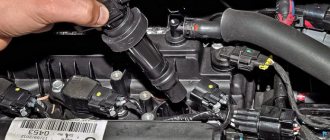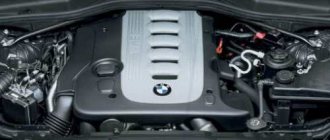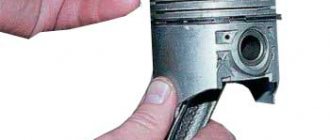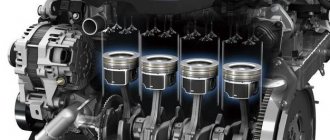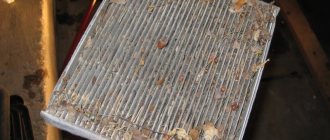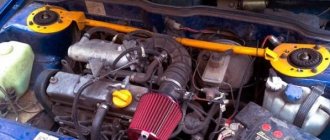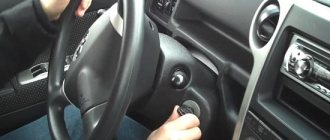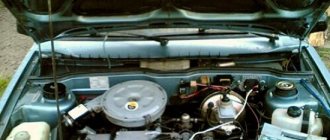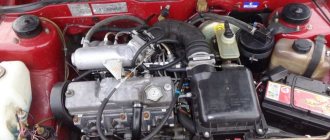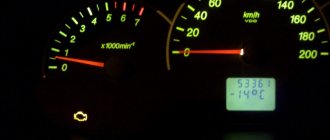Unstable operation of the car engine after starting, vibration and jumps in engine speed at idle, changes in the sound of the engine - these signs indicate engine throttling. This means that one of the car's cylinders is not working or is operating in an unspecified mode.
Troubleshooting of the internal combustion engine is associated with malfunctions in various vehicle systems - electrical, ignition or power systems; as well as with malfunctions of the cylinder head valves or parts of the cylinder-piston group.
If the engine stalls when starting when cold, then it is better not to use the car. An inoperative cylinder will lead to increased fuel consumption, decreased vehicle power, increased wear on the CPG, failure of the catalyst and ignition system elements. Therefore, you should not postpone for long the search and elimination of the causes of engine tripping during warm-up.
Signs of tripling
A motor is a complex technical device that requires constant monitoring by the driver. Without maintenance for a long time, or if the car is operated around the clock, but maintenance is rarely carried out, changes occur in the operation of the engine, which include: noises, knocks, squeaks; power reduction; increased fuel consumption; increased asynchronous vibration; and engine tripping. There are several signs that cause the engine to start to stall:
- Rough engine operation (asynchronous vibration). That is, the motor vibrates randomly, sometimes frequent, sometimes infrequent twitching. This happens when the combustible mixture in one of the cylinders does not ignite.
- One spark plug is not working. This happens when carbon deposits or soot appear on the candle, if the candles are flooded. The problem can be solved by stripping the spark plug, heating it over a fire, burning off the carbon deposits, and checking the gap.
- The car “shoots”, that is, popping sounds are heard from the muffler. This means that there are gaps in the combustion of the combustible mixture in the working chamber of the cylinder, then the ignition is triggered and a bang occurs. This happens with carburetor engines when it was running on choke, which is why overshoot occurred.
- The car accelerates slowly or even stalls if you give the gas sharply. Signs of slow acceleration may also indicate the presence of another problem in the engine.
- Excessive fuel consumption. If one cylinder does not work or fires rarely, then the fuel supplied there simply comes out unburned from the muffler.
- The needle on the tachometer is jumping. On modern cars, a certain corresponding icon may light up on the instrument panel.
- The car jerks while driving.
Consequences
Some motorists do not attach much importance to this malfunction. And this is very wrong, because the consequences can be completely unpredictable. The first thing to note is the increased fuel consumption. If the engine stalls when cold, its consumption will definitely increase. Due to improper combustion, the fuel simply flies out into the pipe, without giving the piston the necessary mechanical push. Thus, when the engine is tripled, fuel consumption can increase by 50, 60, or even 100 percent. In this case, the mixture that is not burned in the cylinder pollutes the atmosphere, destroys the catalyst (it also oxidizes the lambda probe sensor, forming carbon deposits on it) or enters the crankcase, where it is subsequently mixed with oil. Large loads are placed on the crankshaft, engine block and the entire cylinder-piston group. And this significantly affects their resource. If the problem is not corrected in time, engine repairs can be a serious expense for you. Therefore, do not hesitate to remove this malfunction.
Causes of engine tripping
When the engine starts to rev, you can immediately hear changes in its operation. Out-of-sync motor twitching, staggering in discord. This happens that the frequency, the cycle of work is disrupted.
Here are the reasons there may be if the engine starts to stall:
- The ignition timing is incorrectly set.
- There is an air leak in the vacuum brake booster system.
- The spark plug has failed. This is the most common reason, since spark plugs are usually changed until the old ones stop working. Although it is recommended to change it every 20 thousand kilometers of passage.
- The high-voltage wire is broken. These are the wires that go onto the spark plugs.
- The capacitor has failed.
- The tightness of the intake manifold system is broken.
- A valve or piston has burned out, so compression is not created.
- The piston ring is burnt out. Due to this reason, a lot of smoke comes out of the muffler.
- The valves in the gas distribution system are not configured correctly.
- The rockers, that is, the camshaft journals, are worn out.
- The cylinder head gasket is broken.
- The valve stem seals are worn out, that is, they have hardened, pierced, or crumbled.
- If the engine is carburetor, then it often happens that the carburetor is not configured correctly, which causes the supply of fuel and air to be disrupted.
- Worn distributor shaft or turntable shaft bearing.
- The air filter is clogged and does not allow the required amount of air to pass through.
- The diaphragm of the vacuum ignition timing regulator has broken.
- Fresh sparks are not suitable for this engine.
Some of the above reasons are typical only for carburetor engines, for example, cars of the VAZ family.
One of the important rules for keeping the engine in working condition is timely periodic checking of the oil level. Check the oil level with a dipstick with two or three marks marked on it.
Breakdown in high-voltage wires
Less frequently, the engine stalls at idle due to a breakdown in high-voltage wires. But this problem is also completely solvable. It is best to check the serviceability of high-voltage wires in the dark - this way you will see sparks that will pass out. In this case, the engine must be running. But this method does not always help. It happens that the breakdown occurs not in the winding, but inside it, that is, the wires themselves are damaged. In this case, take a multimeter and measure the nominal resistance. Ideally, it should be no more than 20 kOhm. If you notice sparks or changes in resistance levels, replace the high-voltage wires with new ones. But remember that their lengths are different. Therefore, before purchasing, remember their length so as not to buy very short or long ones.
Cold diesel troits
The reasons for diesel engine tripping differ from gasoline engines. Such an engine fails either because the required compression of the fuel mixture is not created, or because the correct fuel supply or its quality is impaired.
Reasons for diesel tripping:
- Airing.
- The glow plugs are faulty.
- The injector is jammed.
- Incorrect valve clearances.
- The timing belt (gas distribution mechanism) and fuel injection pump are not aligned correctly.
Read more about why diesel troits.
Let's sum it up
If you are faced with a problem with a stalling engine, contact us for diagnostics or carry out the simplest checks yourself. Whenever working on a vehicle's electrical systems, be careful. There are known cases of serious injuries from electric shocks when trying to remove a high-voltage wire from a spark plug. Such situations are unacceptable, because risking your health for the sake of handicraft diagnostics of a car is absolutely not necessary.
It is much better to go to a service station and order normal diagnostics of the car by specialists. In this case, you will get the required results much faster and will be able to immediately order a good repair of your vehicle. To summarize, it must be said that any problems in a modern power unit turn out to be quite difficult for self-diagnosis. Have you ever encountered a stalling engine?
Why does the engine injector troit?
The reasons listed above are also typical for injection engines, except for points: 13 and 14. To the reasons for the injector, you can also add the failure of the ignition module or the injector itself is faulty, the injectors are clogged, the injector wires are broken. An experienced motor mechanic is needed to diagnose and repair the injector and injectors.
Before contacting a car service, you should try to fix it yourself. This is possible in many cases, because there are many small reasons that are easy to eliminate on your own. You should start by checking the spark plugs and high-voltage wires. It is not difficult to check the functionality of the spark plugs; you need to start the engine, put on rubber gloves (if the wire is broken, to avoid electric shock), and one by one disconnect the wire from the spark plug. If the cylinder is working as expected, then when the wire is disconnected, the sound of the motor will change and the engine will begin to shake (change vibration). If the cylinder is not working, then disconnecting the wire will not make any changes in the operation of the motor. Therefore, it is necessary to change or clean the spark plug.
Safety precautions when disconnecting wires
Don't forget about safety precautions. After all, these are high-voltage wires, and not small 12-volt “laces”. First of all, you need to place a dielectric under your feet, that is, a material that does not conduct electric current through itself. This can be a rubber mat or a wooden board. Also follow the technology for disconnecting wires. Remember that you need to hold your fingers not on the cap, but on the wire itself. And, of course, it is not recommended to lean against the body with your free bare hand at this time. Remember that if you do not follow these rules, you risk receiving a high voltage electric shock.
Why does a carburetor engine troit?
Dealing with the tripping of a carburetor engine is much easier. In general, such engines are simple due to the lack of computerized systems.
All of the above reasons in the paragraph “reasons for engine tripping” are typical for engines with a carburetor.
Here, accordingly, there can be no problems with the injector or ignition module. The most common reason for cars with such engines is that the spark plug does not work, then the wire from the distributor to the spark plug is broken, then the carburetor is incorrectly configured, then the valve burns out, then the piston burns out or the piston rings fail.
0
Author of the publication
offline 1 week
Low compression or no compression at all
At the first stage, we tried to identify a non-working candle. If you succeed, you can enjoy the low cost of car repairs. If the problem turns out to be deeper, you will have to read more and try to fix the problem. Next you should check the compression in the cylinders. Often, when the engine loses compression, it starts to stall. The compression must be the same in each cylinder, and if this indicator drops too much, the unit has to be repaired. You can measure compression at the station, and the result can be very different:
- depressurization of one of the cylinders and loss of compression;
- too much wear on engine parts, pressure loss;
- problems with the power unit lubrication system, lack of oil supply;
- lack of normal ignition and fuel reaction due to violations;
- splits and cracks in the engine, which clearly lead to replacement;
- the need to perform a major overhaul of the power unit.
To avoid too rapid wear of engine parts and loss of compression, it is necessary to use good oil and follow all manufacturer’s recommendations regarding machine maintenance. This way you can operate the vehicle without any problems, unless there are other reasons for engine failure. If the engine is already malfunctioning and a major overhaul is required, there is no point in delaying the repair work. This can completely damage the power unit.
Power supply system and unstable engine operation
The reliability of the power system is a guarantee of smooth and stable operation of the motor. Let's look at typical faults that cause unstable engine speed.
If the engine runs intermittently, the reasons may be low-quality gasoline. Today, such fuel is sold very often at gas stations. If you fill your car with low-quality fuel, the engine speed will fluctuate and the car will jerk. Sometimes the car simply refuses to move. In this situation, experts recommend draining all fuel and checking the fuel for the presence of water. If the gasoline is completely drained, the entire line is pumped with a pump. It is also a good idea to flush the carburetor and replace the fuel filters.
A clogged fuel filter or carburetor is another possible cause. Debris in the carburetor can cause the engine to fail to start. If the channels or jets are clogged, the combustible mixture will not be able to fully enter the combustion chamber. This will immediately affect the operation of the internal combustion engine.
Problems with injection
Certain specific problems can cause tripping when the engine is running in a car:
- malfunction of the regulator responsible for idle speed;
- blockage in the injection nozzle;
- the fuel pump, air or fuel filter is clogged;
- the sensor responsible for the throttle position has failed;
- the ventilation system providing air to the engine crankcase is clogged;
- ECU is faulty.
Separately, it is necessary to note the problems of the “tens” with sensors. Although their cost is insignificant, problems with them arise quite often. They often require replacement. First of all, this applies to the sensor responsible for mass fuel consumption. The second most common problem is the sensor that is responsible for the throttle position. The risk zone is not complete without an idle air regulator. All these elements require constant monitoring of their condition.
The motor may not operate correctly if the firmware of the electronic control part is poor. This can happen if tuning is used unwisely. At high speeds the car operates normally, but at idle it starts to shake. Sometimes the ECU may have defects that cannot be corrected. In this case, the only way out of this situation is to completely replace the electronic unit.
It would be a good idea to check the exhaust manifold for leaks. It doesn’t hurt to inquire about the condition of the vacuum brake booster. If it malfunctions, the spark plugs may get wet, which will also cause the engine to start to “trouble.”
We can only hope that the article will help car owners in solving this problem.
Glow plug malfunction
Glow plugs, at least indirectly, take part in the atomization of fuel. When injection occurs, diesel fuel, flowing in a high-pressure jet from the nozzle, inevitably hits the hot plug. This makes the fuel in the cylinder atomized even more efficiently. Contact with the spark plug ensures that the diesel fuel scatters into small particles, the fuel partially evaporates and is guaranteed to mix better with the air.
All this ensures the most efficient combustion of the fuel-air mixture in the cylinder. If the condition of the spark plug is not working, then you will definitely not be able to successfully start a cold diesel engine. The temperature in the cylinder will drop, which is why the fuel is no longer capable of self-ignition. Fuel will continue to flow into the cylinder, but it will be virtually inactive. The fuel then enters the exhaust system, causing the engine to start smoking black or dark gray exhaust.
When the temperature in the internal combustion engine rises, the diesel fuel will still light up, but only if everything is in order with compression. However, even in this case the unit will work with obvious interruptions and delays. When the diesel engine warms up well, the problem will disappear, but then it will happen again.
